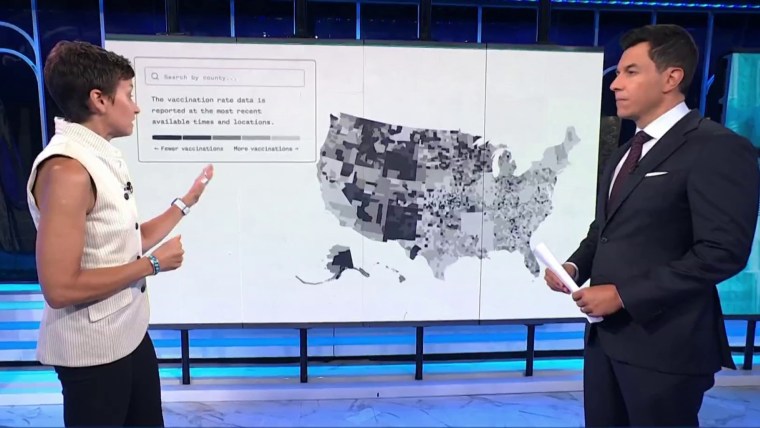This year's lethal spread of measles in rural West Texas and other pockets of the U.S. was a strong warning about how protection against deadly childhood diseases is eroding around the nation.
This was a key conclusion of a six-month NBC News investigation, in collaboration with Stanford University, resulting in the most comprehensive analysis of vaccinations and school exemptions to date.
NBC News gathered massive amounts of data from state governments and archives of public records reaching back years or decades. With the help of infectious disease researchers at Stanford, NBC News filed scores of requests for documents, including materials obtained under the Freedom of Information Act, and wrestled different types of data into a standardized format to map and compare rates across thousands of counties.
The analysis found that a large swath of the U.S. currently does not have the basic, ground-level immunity medical experts believe is necessary to stop the spread of measles, which had once receded into the past.
NBC News data investigation: How progress against childhood diseases is backsliding.
- The Vaccine Divide: Much of the U.S. currently doesn't have the protection needed to prevent outbreaks, the monthslong investigation reveals. One key finding of the analysis is stunning.
- St. Louis offers a window into the overwhelming problem communities face nationwide.
- How protected is your community? Search for current vaccination exemption rates in thousands of counties across the U.S. and see how the numbers have changed over time.
The idea for this project originated from a conversation about how to cover changes in vaccine policy and opinion between the NBC News Health and Medical unit and Dr. Peter Hotez, a vaccine expert and dean of the National School of Tropical Medicine at Baylor College of Medicine in Dallas.
The conversation led to infectious diseases scientist Dr. Nathan Lo at Stanford University, who had mapped out vaccination and exemption data in a few states. Lo became a collaborator in this monthslong data project, helping identify the limitations of the broader state-level vaccination trends that are collected by the Centers for Disease Control and Prevention.
Outbreaks start locally
We put vaccination trends under a microscope, down to the county level. The findings could help public health officials better predict where the next outbreak may occur and how to best allocate resources to stop it.
Or parents of children at high risk of complications from infectious diseases could find out if their community is a potential hot spot.
The analysis has identified unexpected trends.
For example, St. Louis, a diverse, major metropolitan area, is in the midst of a slide in immunization rates. That’s why it is a reporting focus.
These findings uncover a fracture in an already fragmented society: The vaccine divide.
Our Methodology
How NBC News collected the data
NBC News built a database of kindergarten vaccination and exemption information using data provided by state governments, primarily health agencies. The data combines public information available for some states and data provided directly to NBC News.
The data covers kindergartner vaccinations for each academic year.
After collection, the data was collated and exemption rates were calculated in order to be analyzed. The analysis focuses on four facets of the data:
- Medical exemptions: Exemptions granted when students have a medical condition that would make vaccination potentially harmful.
- Nonmedical exemptions: Exemptions for students who opt out of required vaccinations due to personal beliefs or religious convictions.
- MMR (measles-mumps-rubella) vaccinations: For states in which data is subdivided by number of doses, MMR vaccination is counted by the second dose.
- Up-to-date vaccinations: Students are considered “up-to-date” with their vaccinations if they have received the full vaccination series required for enrollment in their school.
How the data was processed
With a hodgepodge of formats, jurisdictions and collection practices across states, the task required extensive work to ensure that possible inconsistencies in the data were managed.

